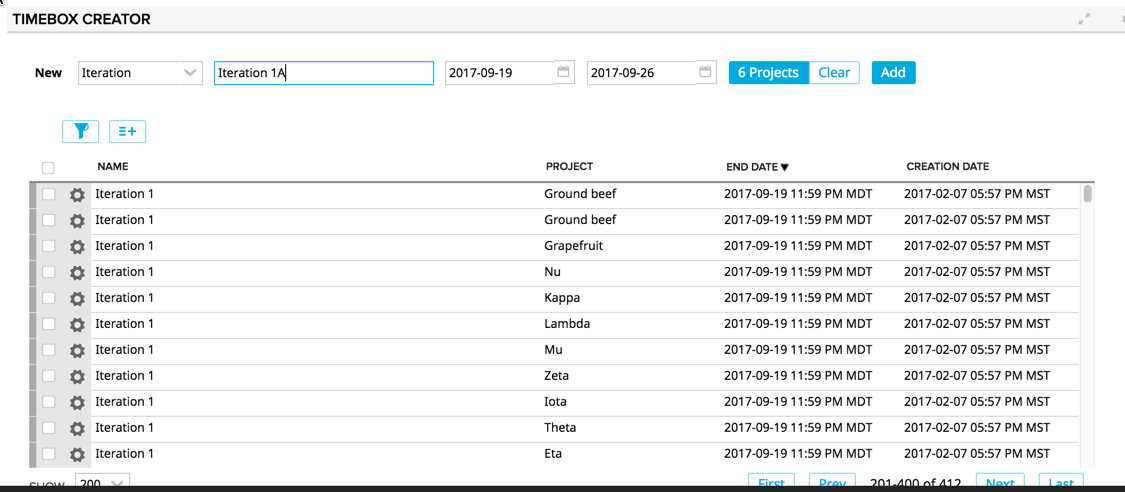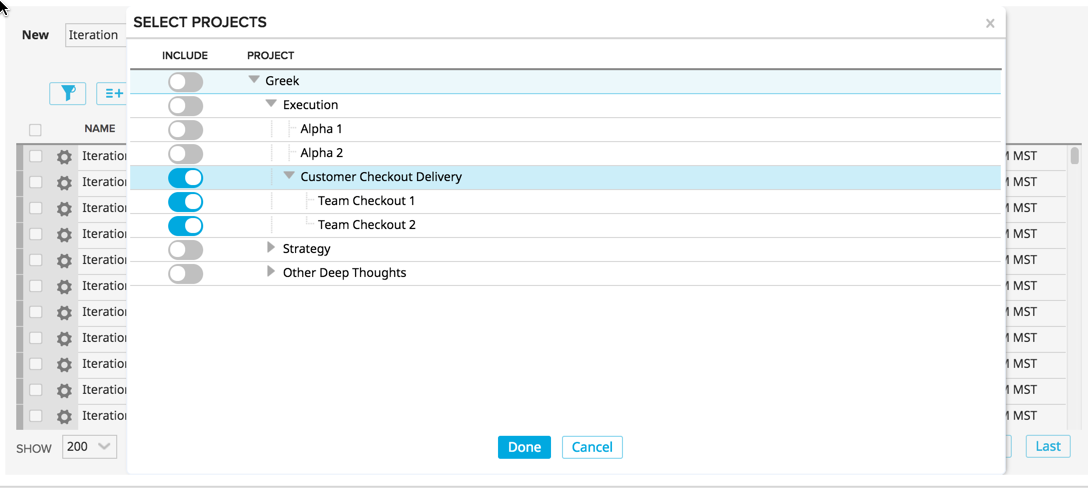#Timebox Creator
Summary/Description
App that allows for creation of aligned timeboxes (Releases or Iterations) for a selected group of projects. The grid for timeboxes include Bulk Edit and Bulk Delete functionality.
 Select the timebox type from the "New" dropdown
Select the timebox type from the "New" dropdown
Add a Timebox Name, Start Date and End Date
If desired, click Select Projects to select specific projects to create the timebox for

If no projects are selected, then the selected timebox will be created for all projects in the current scope.
The projects shown in the project selector are only projects within the current Project scope.
Click "Add" to create the projects. A notification will be displayed when all projects are complete.
The grid will show all timeboxes of the selected type. The grid can be filtered and columns added per type.
Development Notes
First Load
If you've just downloaded this from github and you want to do development, you're going to need to have these installed:
- node.js
- grunt-cli
- grunt-init
Since you're getting this from github, we assume you have the command line version of git also installed. If not, go get git.
If you have those three installed, just type this in the root directory here to get set up to develop:
npm install
Structure
- src/javascript: All the JS files saved here will be compiled into the target html file
- src/style: All of the stylesheets saved here will be compiled into the target html file
- test/fast: Fast jasmine tests go here. There should also be a helper file that is loaded first for creating mocks and doing other shortcuts (fastHelper.js) Tests should be in a file named -spec.js
- test/slow: Slow jasmine tests go here. There should also be a helper file that is loaded first for creating mocks and doing other shortcuts (slowHelper.js) Tests should be in a file named -spec.js
- templates: This is where templates that are used to create the production and debug html files live. The advantage of using these templates is that you can configure the behavior of the html around the JS.
- config.json: This file contains the configuration settings necessary to create the debug and production html files.
- package.json: This file lists the dependencies for grunt
- auth.json: This file should NOT be checked in. Create this to create a debug version of the app, to run the slow test specs and/or to use grunt to install the app in your test environment. It should look like: { "username":"you@company.com", "password":"secret", "server": "https://rally1.rallydev.com" }
Usage of the grunt file
####Tasks
grunt debug
Use grunt debug to create the debug html file. You only need to run this when you have added new files to the src directories.
grunt build
Use grunt build to create the production html file. We still have to copy the html file to a panel to test.
grunt test-fast
Use grunt test-fast to run the Jasmine tests in the fast directory. Typically, the tests in the fast directory are more pure unit tests and do not need to connect to Rally.
grunt test-slow
Use grunt test-slow to run the Jasmine tests in the slow directory. Typically, the tests in the slow directory are more like integration tests in that they require connecting to Rally and interacting with data.
grunt deploy
Use grunt deploy to build the deploy file and then install it into a new page/app in Rally. It will create the page on the Home tab and then add a custom html app to the page. The page will be named using the "name" key in the config.json file (with an asterisk prepended).
To use this task, you must create an auth.json file that contains the following keys: { "username": "fred@fred.com", "password": "fredfredfred", "server": "https://us1.rallydev.com" }
(Use your username and password, of course.) NOTE: not sure why yet, but this task does not work against the demo environments. Also, .gitignore is configured so that this file does not get committed. Do not commit this file with a password in it!
When the first install is complete, the script will add the ObjectIDs of the page and panel to the auth.json file, so that it looks like this:
{ "username": "fred@fred.com", "password": "fredfredfred", "server": "https://us1.rallydev.com", "pageOid": "52339218186", "panelOid": 52339218188 }
On subsequent installs, the script will write to this same page/app. Remove the pageOid and panelOid lines to install in a new place. CAUTION: Currently, error checking is not enabled, so it will fail silently.
grunt watch
Run this to watch files (js and css). When a file is saved, the task will automatically build and deploy as shown in the deploy section above.